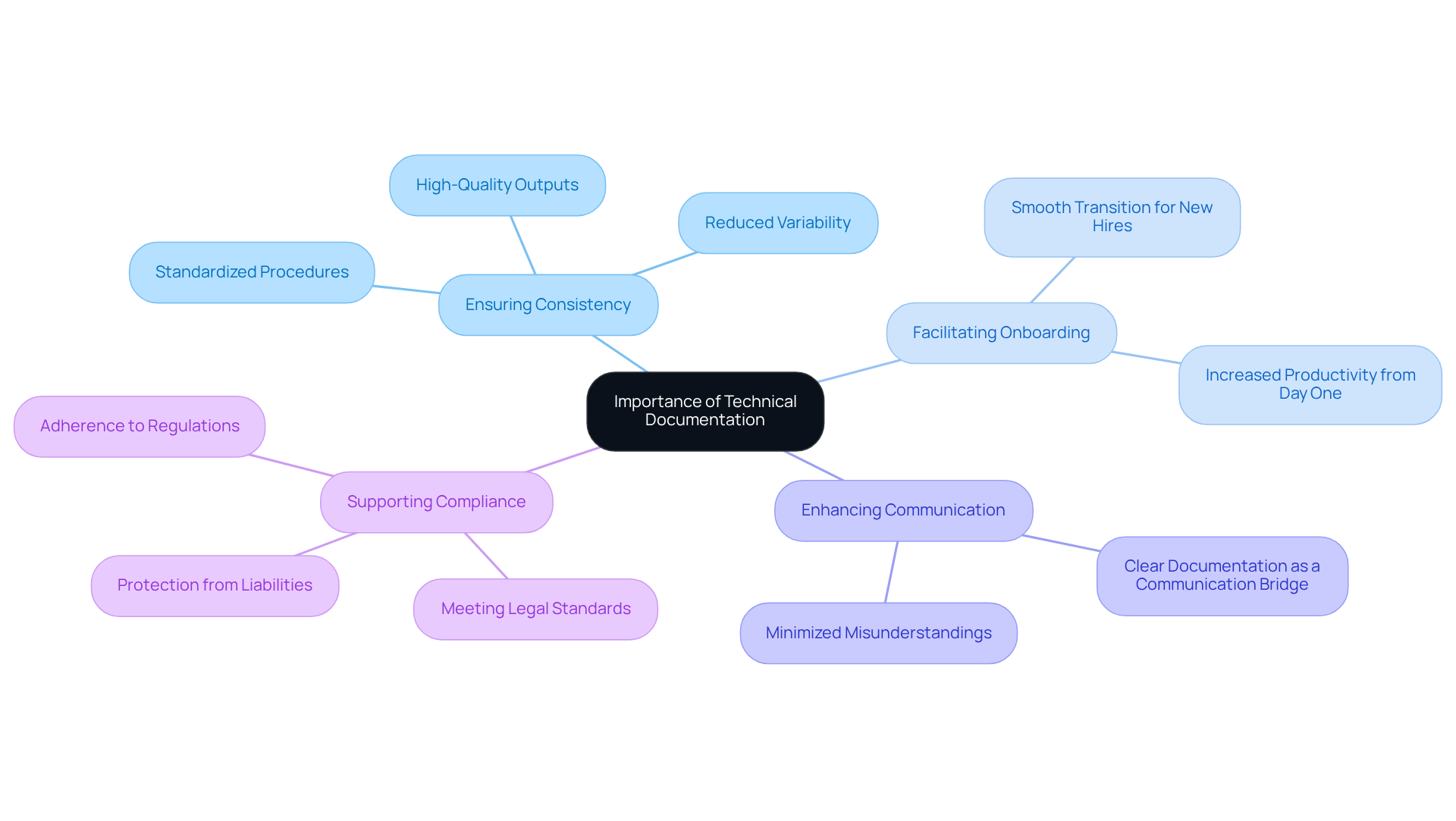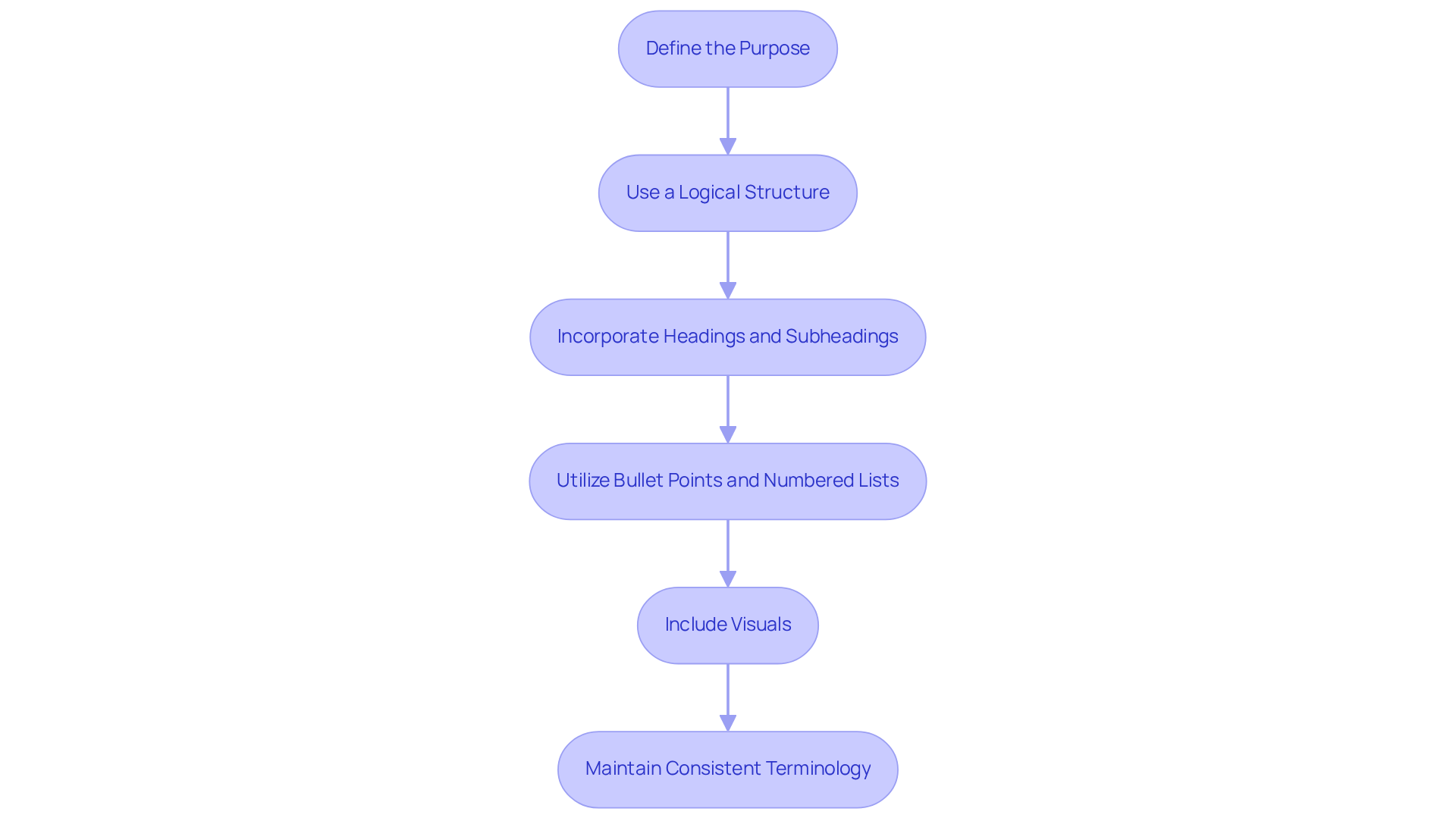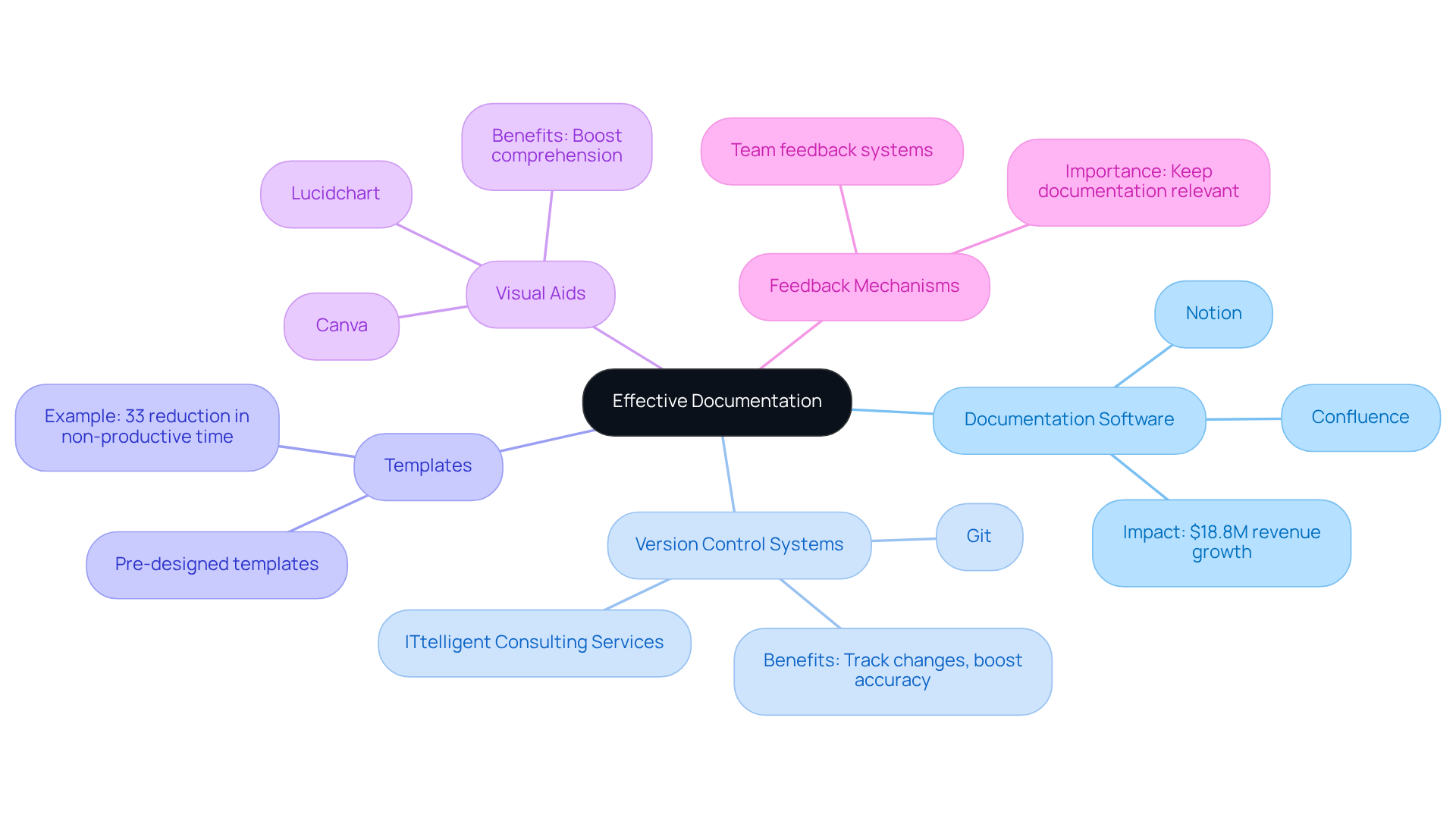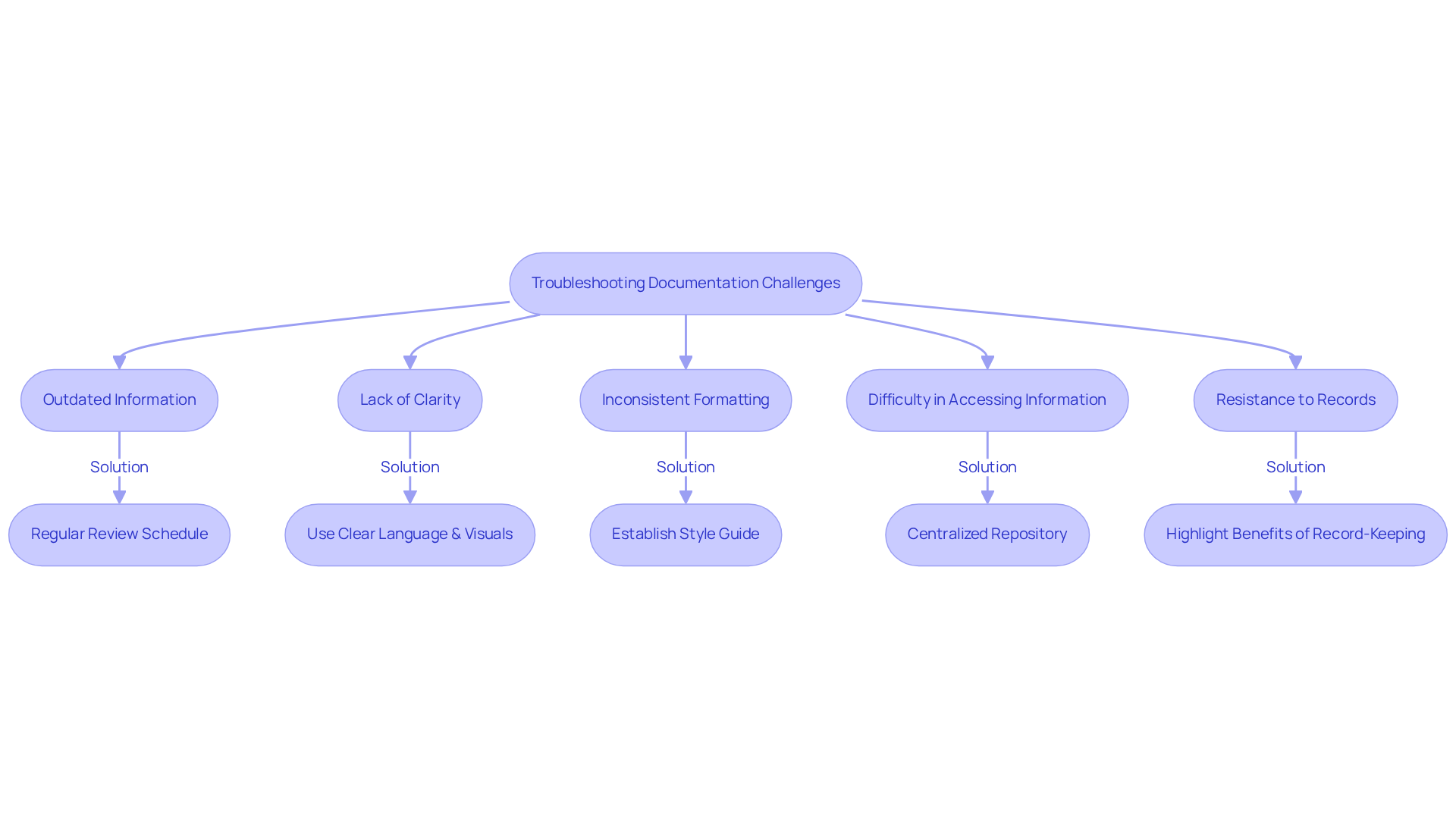
Overview
Have you ever thought about the essential elements of writing technical documentation for operations managers? It’s really important, and here's why: it helps ensure consistency, makes onboarding smoother, enhances communication, and supports compliance.
So, what are the best practices? Well, you’ll want to start by:
- Clearly defining the document's purpose.
- Maintaining a logical structure.
- Considering visual aids; they can make a world of difference.
- Using documentation tools to tackle common issues like outdated information and lack of clarity.
In the end, all of this contributes to improving overall operational efficiency. Now, let’s dive into how you can implement these strategies effectively!
Key Highlights:
- Technical documentation ensures consistency in processes, reducing errors and variability.
- Clear documentation facilitates onboarding, helping new employees become productive quickly.
- Effective documentation enhances communication between teams, fostering collaboration and minimising misunderstandings.
- In regulated industries, proper documentation supports compliance with legal standards.
- Best practises for writing technical documentation include defining purpose, logical structure, and consistent terminology.
- Utilising documentation software and version control systems improves collaboration and accuracy.
- Visual aids like diagrams and infographics enhance understanding of complex processes.
- Common documentation challenges include outdated information, lack of clarity, inconsistent formatting, and difficulty accessing information.
- Establishing a regular review schedule and a centralised repository can mitigate these challenges.
Introduction
You might be wondering how technical documentation can really make a difference in operations management. It’s true—this documentation is like the backbone of effective operations management, yet many organizations find it tough to tap into its full potential.
In this guide, we’ll explore some essential practices and tools that can help operations managers craft documentation that’s clear, consistent, and compliant.
But as the landscape of modern business shifts, how can you ensure your documentation not only meets today’s needs but is also ready for tomorrow’s challenges? Let’s dive into that!
Understand the Importance of Technical Documentation
You might be wondering how to write technical documentation and why it is such a big deal for operations managers. Well, it’s all about having a solid way to capture and share knowledge within your organization, which includes understanding how to write technical documentation. Let’s break down some of the key benefits:
- Ensuring Consistency: By documenting processes, teams can stick to standardized procedures, which really helps reduce variability and cut down on errors. This consistency is super important for keeping your outputs high-quality and ensuring everything gets delivered on time.
- Facilitating Onboarding: When procedures clearly outline how to write technical documentation, new employees can jump right in and start being productive from day one. Organizations that prioritize record-keeping often find that new hires transition more smoothly, which means they fit into teams faster.
- Enhancing communication involves knowing how to write technical documentation, as clear documentation acts like a communication bridge between different teams, ensuring everyone is on the same page regarding processes and expectations. This clarity helps foster collaboration and minimizes misunderstandings that could lead to inefficiencies.
- Supporting Compliance: In regulated industries, knowing how to write technical documentation is crucial for meeting legal and compliance standards. Keeping proper records protects organizations from potential liabilities and ensures they’re following regulations, like the new EU Machinery Directive, which requires machine instructions to be available online for at least ten years.
Recognizing how to write technical documentation is just the first step toward creating a more efficient and organized operational environment. By using effective record-keeping methods, you can enhance onboarding, boost operational efficiency, and ensure compliance, which is crucial for understanding how to write technical documentation that gives your organization a competitive edge in the industry.
Now, let’s talk about how efficient record-keeping can really ramp up productivity and cut down on the time spent on paperwork. As Anastasia Masadi, a Product Owner, puts it, "This tool has revolutionized our record-keeping process, enabling me to create SOPs and training materials without exiting the browser, conserving valuable time." This transformation in record-keeping efficiency shows just how SowFlow helps teams produce SOPs and training materials in a snap.

Structure Your Documentation for Clarity and Usability
Creating clear and usable technical documentation is essential, and learning how to write technical documentation can make the process easier! Let’s break it down into some essential steps you can follow:
- Define the Purpose: What’s the document all about? Clearly articulating its objective is key. Identify the problem it addresses and who it’s for—this ensures your content stays relevant.
- Use a Logical Structure: Think of how you’d want to read it. Start with an introduction, dive into the details, and wrap it up with a summary or actionable next steps.
- Incorporate Headings and Subheadings: Headings are your best friends here! They help segment the text and guide readers through your document, making it easier for them to find what they need.
- Utilize Bullet Points and Numbered Lists: Got a lot to say? Present it concisely with bullet points or numbered lists. This format boosts readability and helps convey complex information clearly.
- Include Visuals: Don’t underestimate the power of visuals! Diagrams, screenshots, and flowcharts can really enhance understanding, especially for intricate processes. They also keep the reader engaged.
- Maintain Consistent Terminology: Consistency is crucial. Using the same terms throughout your document prevents confusion and boosts clarity. It’s all about making it easier for your readers.
By following these best practices on how to write technical documentation, you can create records that are not only informative but also user-friendly. This makes navigation and understanding a breeze for everyone involved. With a quick solution for records, you can simplify the creation and updating of user guides, ensuring that your materials stay relevant in a fast-paced business world. The platform’s features, like easy updates and intuitive templates, help teams maintain clarity and efficiency in their processes. As Hannah Kaufhold wisely puts it, 'Clear language is more than a writing style — it’s a tool to enhance technical literature.' So, by leveraging SowFlow's features along with these best practices, you can produce efficient records that meet your team's needs while avoiding the common pitfalls that lead to wasted resources.

Leverage Tools and Resources for Effective Documentation
To enhance your documentation process, you might be wondering how to write technical documentation to make it easier and more effective. Consider leveraging some handy tools and resources:
- Documentation Software: Platforms like Confluence and Notion are super popular for creating and organizing documentation efficiently. They promote collaboration and make sure everyone on your team has access to the latest info. For instance, a worldwide aviation solutions company saw a whopping $18.8 million in revenue growth through better record-keeping practices. That really shows the power of efficient document management software!
- Version Control Systems: Now, let’s dive into version control. Implementing systems like Git allows teams to track changes closely and collaborate seamlessly on written materials. This practice boosts accuracy and accountability, ensuring that all modifications are documented and easily reversible. As ITtelligent Consulting Services pointed out, using monitoring software has helped them be more proactive in caring for client systems—just like version control does for records.
- Templates: You know what else can save you time? Using pre-designed templates for common documents like standard operating procedures (SOPs) and user manuals. This not only simplifies your writing tasks but also ensures consistency across all your documents. For example, a South American sanitation firm reduced non-productive time by 33% thanks to improved record-keeping methods. Talk about efficiency!
- Visual Aids: Speaking of clarity, tools like Lucidchart or Canva can help you create diagrams and infographics that make complex processes easier to understand. Visual representations can really boost comprehension and help people remember information better, making your records more accessible.
- Feedback Mechanisms: Lastly, let’s not forget about feedback! Establishing systems for team members to share their thoughts on materials is crucial for keeping things relevant and accurate. Regular assessments and revisions based on user feedback ensure that your written materials evolve alongside your organization’s needs. Industry leaders emphasize that ongoing improvement in record-keeping practices is vital for adapting to rapid business changes.
By incorporating these tools into your record-keeping strategy, operations managers can simplify the process, making things more efficient and effective. So, what do you think? Ready to give these a try?

Troubleshoot Common Documentation Challenges
Operations managers, you might find it tricky to create and keep those technical records up to date. Let’s dive into some common challenges and how you can tackle them effectively:
- Outdated Information: Keeping your records fresh is key to accuracy. How about setting up a regular review schedule? This way, you can ensure that everything reflects the latest practices and standards. Plus, the company’s immediate record-keeping solution makes updating a breeze, so your guides stay relevant in this fast-paced business world.
- Lack of Clarity: If your materials are hard to understand, it’s time to simplify! Try using clearer language and adding visuals. Don’t forget to ask for feedback from your users—after all, 46% of employees struggle to find the info they need. With a user-friendly platform, you can boost clarity and make access a lot easier for your team.
- Inconsistent Formatting: Ever noticed how different documents can look? Establishing a style guide can help keep things uniform in formatting, terminology, and tone. This consistency not only improves understanding but also builds confidence in your materials. The platform’s tools can help you create user manuals that are spot on every time.
- Difficulty in Accessing Information: Organizing your records in a centralized repository with a clear indexing system can work wonders. With SowFlow’s solution, you’ll streamline processes and enhance knowledge sharing, making it a cinch for employees to find what they need. Imagine cutting down the average 2.5 hours spent searching for information each day!
- Resistance to Records: It’s all about culture! Highlight the benefits of good record-keeping, like boosting efficiency and cutting down training time for new hires. Sharing success stories, like PharmaCare’s impressive 40% reduction in document search time after implementing a structured system, can motivate your team to embrace these practices.
By proactively addressing these challenges with creative solutions, you can significantly enhance how to write technical documentation, improving the quality and usability of your technical materials. Want to learn more? Contact us to discover how SowFlow can revolutionize your documentation process and provide insights on how to write technical documentation, leading to better operational efficiency and compliance!

Conclusion
You might be wondering why understanding how to write technical documentation is so crucial for operations managers. Well, it’s all about enhancing efficiency and communication within your organization! This guide has highlighted the importance of technical documentation, showing how it ensures consistency, facilitates onboarding, boosts communication, and supports compliance. By taking a strategic approach to documentation, you can build a structured and effective framework that meets both your current and future needs.
Let’s dive into some key insights from this article! Clear structure and usability in documentation are vital, and leveraging modern tools can make a world of difference. Plus, troubleshooting common challenges is a must. By defining the purpose of each document, using logical structures, and gathering feedback, you can significantly enhance the quality and accessibility of your technical records. And don’t forget about technology—documentation software and version control systems can really streamline the process and foster collaboration among your teams.
In conclusion, creating effective technical documentation isn’t just a skill—it’s a game changer for organizations looking to thrive in today’s competitive landscape. By prioritizing clear, consistent, and user-friendly documentation practices, you can cultivate a culture of knowledge sharing and continuous improvement. So, why not adopt these strategies? They’ll not only boost operational efficiency but also empower your teams to adapt quickly to evolving challenges. Embrace the power of effective documentation today and transform how your organization captures and shares knowledge!
Frequently Asked Questions
What is the importance of technical documentation for operations managers?
Technical documentation is crucial for capturing and sharing knowledge within an organization, ensuring consistency in processes, facilitating onboarding, enhancing communication, and supporting compliance with legal standards.
How does technical documentation ensure consistency in operations?
By documenting processes, teams can adhere to standardized procedures, which helps reduce variability and minimize errors, leading to high-quality outputs delivered on time.
In what way does technical documentation facilitate onboarding for new employees?
Clear documentation allows new employees to understand procedures quickly, enabling them to become productive from day one and transition smoothly into their teams.
How does technical documentation enhance communication within teams?
It acts as a communication bridge, ensuring that all team members are aligned regarding processes and expectations, which fosters collaboration and reduces misunderstandings.
Why is technical documentation important for compliance in regulated industries?
Proper documentation is essential for meeting legal and compliance standards, protecting organizations from liabilities, and ensuring adherence to regulations, such as the EU Machinery Directive.
What are the benefits of effective record-keeping in relation to technical documentation?
Effective record-keeping enhances onboarding, boosts operational efficiency, ensures compliance, and ultimately provides a competitive edge in the industry.
How can efficient record-keeping impact productivity?
Efficient record-keeping can significantly reduce the time spent on paperwork, allowing teams to create standard operating procedures (SOPs) and training materials quickly, which improves overall productivity.
👍
What others are liking
5 Steps to outline your ideal documentation structure
5 MINS READ
Where to start the your journey of mapping out your ideal documentation structure, aligning it with the very heartbeat of your organization?
Defining a winning level of detail in your process
3 MINS READ
What is too much detail, and what is too little? This article described in that winning level detail about what detail is enough.





